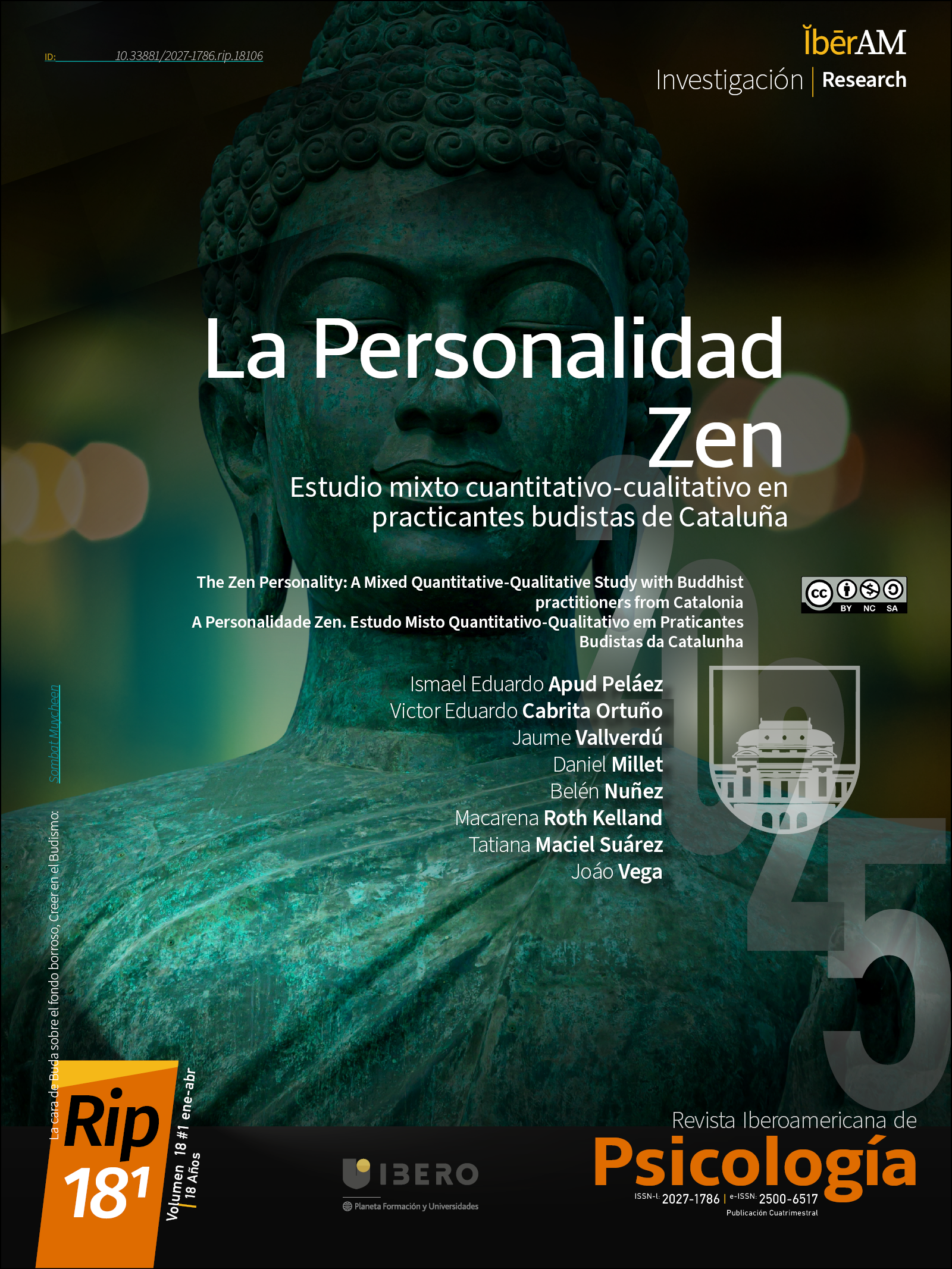The Zen Personality. A Mixed Quantitative-Qualitative Study with Buddhist practitioners from Catalonia
La Personalidad Zen. Estudio mixto cuantitativo-cualitativo en practicantes budistas de Cataluña
Main Article Content
In the field of psychology and health sciences, there is a growing interest in recent decades in Buddhist practice and its positive impact on mental health. In this article, we will study the relationship between practice, community, and Buddhist beliefs on one hand, and personality and subjective temporality on the other. To do this, we conducted research with practitioners belonging to a Zen group in Barcelona. We used a mixed quantitative-qualitative design, including psychometric scales (Zuckerman-Kuhlman-Aluja Personality Questionnaire/Short-Form and Dark Future Scale) and semi-structured interviews. The quantitative sample consisted of 25 practitioners, who were compared with a religious and a non-religious group. We found significantly lower scores, with a medium effect size, in the Sensation Seeking-Impulsivity trait when comparing the Zen group with the non-religious group. In the 8 qualitative interviews conducted, we identified an "ascetic" profile among the practitioners. The studied Zen Buddhists could be described as spiritual seekers who, disenchanted with Catholicism and modern materialism, find their place in Zen practice and philosophy. Practitioners expressed in the interviews the impact of meditation - followed by beliefs and community, respectively - on impulse control, emotions, anxiety, behaviors, and thoughts. Summarizing, the current study suggests certain psychological characteristics of Zen Buddhists: an ascetic profile characterized by a certain disinterest and dissatisfaction towards Western values and socialization spaces, and a potential positive effect of zazen practice over the control of impulsivity, emotions, and behaviors.
Publication Facts
Reviewer profiles N/A
Author statements
- Academic society
- Bogotá: Corporación Universitaria Iberoamericana
- Publisher
- Bogotá: Corporación Universitaria Iberoamericana
Article Details
Aluja, A., Blanch, A., Martí-Guiu, M., & Blanco, E. (2017). Inconsistency index for the zuckerman-kuhlman-aluja personality questionnaire (ZKA-PQ). European Journal of Psychological Assessment, 33(1), 38-46. https://doi.org/10.1027/1015-5759/a000270 DOI: https://doi.org/10.1027/1015-5759/a000270
Aluja, A., Kuhlman, M., & Zuckerman, M. (2010). Development of the Zuckerman-Kuhlman-Aluja Personality Questionnaire (ZKA-PQ): A factor/facet version of the Zuckerman-Kuhlman Personality Questionnaire (ZKPQ). Journal of Personality Assessment, 92(5), 416-431. https://doi.org/10.1080/00223891.2010.497406 DOI: https://doi.org/10.1080/00223891.2010.497406
Aluja, A., Lucas, I., Blanch, A., García, O., & García, L. F. (2018). The Zuckerman-Kuhlman-Aluja Personality Questionnaire shortened form (ZKA-PQ/SF). Personality and Individual Differences, 134, 174-181. https://doi.org/10.1016/j.paid.2018.06.015 DOI: https://doi.org/10.1016/j.paid.2018.06.015
Aluja, A., Rossier, J., Oumar, B., García, L. F., Bellaj, T., Ostendorf, F., Ruch, W., Wang, W., Kövi, Z., Ścigała, D., Čekrlija, Đ., Stivers, A. W., di Blas, L., Valdivia, M., ben Jemaa, S., Atitsogbe, K. A., Hansenne, M., & Glicksohn, J. (2020). Multicultural Validation of the Zuckerman–Kuhlman–Aluja Personality Questionnaire Shortened Form (ZKA-PQ/SF) Across 18 Countries. Assessment, 27(4), 728-748. https://doi.org/10.1177/1073191119831770 DOI: https://doi.org/10.1177/1073191119831770
Apud, I. (2013). Repensar el Método Etnográfico. Hacia una etnografía multitécnica, reflexiva y abierta al diálogo interdisciplinario. Antipodas. Revista de Antropología y Arqueología, 16, 213-235.
Apud, I. (2020). Ayahuasca: between cognition and culture. Perspectives from an interdisciplinary and reflexive ethnography. Publicacions URV. http://llibres.urv.cat/index.php/purv/catalog/book/428
Apud, I. (2021). Modern Buddhism and its Cultural Translations. Reflections from a Qualitative Case Study of Two European Zen Monks. Arxiu d’Etnografia de Catalunya, 23, 207-232. https://doi.org/10.17345/aec23.207-232 DOI: https://doi.org/10.17345/aec23.207-232
Apud, I., Ortuño, V., Acuña, A., Diaz, M., Morales, E., Rodríguez, M., & Segredo, R. (2023). Budismo Tibetano y Personalidad. Estudio cualitativo sobre el impacto subjetivo del budismo en la personalidad y ansiedad de futuro de practicantes uruguayos. Persona, 26(2). DOI: https://doi.org/10.26439/persona2023.n26(2).6305
Apud, I., Ortuño, V. E. C., Azambuya España, M. N., Pérez Medina, E., Reimondo Silva, M. R., González Revello, V., Paolillo, S., & Pedraja Moreira, N. V. (2022). Budismo y Personalidad. Estudio mixto cualitativo-cuantitativo en la Soka Gakkai Internacional del Uruguay. Persona, 25(2), 39-64. https://doi.org/10.26439/persona2022.n25(2).6140 DOI: https://doi.org/10.26439/persona2022.n25(2).6140
Apud, I., Ortuño, V., Reimondo, M. R., & González Revello, V. (2022). Personality Traits and Future Anxiety in Buddhisms: a Study of Adult Tibetan Buddhist Practitioners from Uruguay. International Journal of Latin American Religions, 6(2), 171-184. DOI: https://doi.org/10.1007/s41603-022-00181-7
Apud, I., & Romaní, O. (2017). Medicine, religion and ayahuasca in Catalonia. Considering ayahuasca networks from a medical anthropology perspective. International Journal of Drug Policy, 39, 28-36. https://doi.org/10.1016/j.drugpo.2016.07.011 DOI: https://doi.org/10.1016/j.drugpo.2016.07.011
Apud, I., & Romaní, O. (2020). Medical anthropology and symbolic cure: from the placebo to cultures of meaningful healing. Anthropology & Medicine, 27(2), 160-175. https://doi.org/0.1080/13648470.2019.1649542 DOI: https://doi.org/10.1080/13648470.2019.1649542
Berkowitz, W. R. (1967). Use of the Sensation-Seeking Scale with Thai Subjects. Psychological Reports, 20(2), 635-641. https://doi.org/10.2466/pr0.1967.20.2.635 DOI: https://doi.org/10.2466/pr0.1967.20.2.635
Clobert, M., Saroglou, V., & Hwang, K. K. (2015). Buddhist Concepts as Implicitly Reducing Prejudice and Increasing Prosociality. Personality and Social Psychology Bulletin, 41(4), 513-525. https://doi.org/10.1177/0146167215571094 DOI: https://doi.org/10.1177/0146167215571094
Cornejo, M. (2012). Religión y espiritualidad, ¿dos modelos enfrentados? Trayectorias poscatólicas entre budistas Soka Gakkai. Revista Internacional de Sociología, 70(2), 327-346. DOI: https://doi.org/10.3989/ris.2010.09.08
Davidman, L., & Greil, A. L. (2007). Characters in Search of a Script: The Exit Narratives of Formerly Ultra‐Orthodox Jews. Journal for the Scientific Study of Religion, 46(2), 201-216. DOI: https://doi.org/10.1111/j.1468-5906.2007.00351.x
Davidson, R. J., Goleman, D. J., & Schwartz, G. E. (1976). Attentional and affective concomitants of meditation: A cross-sectional study. Journal of Abnormal Psychology, 85(2), 235-238. https://doi.org/10.1037/0021-843X.85.2.235 DOI: https://doi.org/10.1037//0021-843X.85.2.235
Denzin, N. (1970). The Research Act: A theoretical introduction to sociological methods. Aldine-Atherton.
Deshimaru, T. (1986). Autobiografía de un monje zen. Kier.
Díez de Velasco, F. (2013). El budismo en España. Historia, visibilización e implantación. Akal Universitaria.
Giannini, M., Loscalzo, Y., Beraldi, D., & Gori, A. (2018). Psychological Resources, Personality Traits and Buddhism: A Study of Italian Young Adults. Journal of Religion and Health, 57(6), 2416–2430. https://doi.org/10.1007/s10943-018-0618-y DOI: https://doi.org/10.1007/s10943-018-0618-y
Koenig, H. G., Siegler, I. C., Meador, K. G., & George, L. K. (1990). Religious coping and personality in later life. International Journal of Geriatric Psychiatry, 5(2), 123–131. https://doi.org/10.1002/gps.930050210 DOI: https://doi.org/10.1002/gps.930050210
MacPhillamy, D. J. (1986). Some Personality Effects of Long-Term Zen Monasticism and Religious Understanding. Journal for the Scientific Study of Religion, 25(3), 304-319. https://doi.org/10.2307/1386295 DOI: https://doi.org/10.2307/1386295
McMahan, D. L. (2008). The Making of Buddhist Modernism. Oxford University Press. DOI: https://doi.org/10.1093/acprof:oso/9780195183276.001.0001
McRae, J. R. (2004). Seeing through Zen: Encounter, transformation, and genealogy in Chinese Chan Buddhism. En Seeing through Zen: Encounter, Transformation, and Genealogy in Chinese Chan Buddhism. https://doi.org/10.5860/choice.42-0252 DOI: https://doi.org/10.1525/9780520937079
Mikulas, W. L. (1990). Mindfulness, self-control, and personal growth. En M. G. T. Kwee (Ed.), Psychotherapy, Meditation, and Health (pp. 151-164). East West Publications.
Ortuño, V. (2020). Aproximaciones a la temporalidad subjetiva: la perspectiva temporal en foco. En V. Ortuño & A. Vázquez-Echeverría (Eds.), Psicología del Tiempo. Una Introducción a la temporalidad en las ciencias del comportamiento (pp. 79-124). Comisión Sectorial de Investigación Científica -Universidad de la República.
Paloutzian, R. F., Richardson, J. T., & Rambo, L. R. (1999). Religious Conversion and Personality Change. Journal of Personality, 67, 1047-1079. DOI: https://doi.org/10.1111/1467-6494.00082
Pániker, A. (2019). Las Tres Joyas. El Buda, su enseñanza y la comunidad. Editorial Kairós.
Pardo, I. (2011). Innovaciones de diseños de investigación y criterios “bilingues” de Validez. Estudios sociológicos, 29(87), 899-924.
Pew Research Center (2012). The Global Religious Landscape. A Report on the Size and Distribution of the World’s Major Religious Groups as of 2010. Pew - Templeton. https://assets.pewresearch.org/wp-content/uploads/sites/11/2014/01/global-religion-full.pdf
Prat, J., Anguera, M., Caudet, F., Dittwald, D., Reche, J., Tomas, I., & Vivancos, I. (2012). Els nous imaginaris culturals. Espiritualitats orientals, teràpies naturals i sabers esotèrics. Publicacions URV.
R Core Team (2020) R: A language and environment for statistical computing. R foundation for Statistical Computing.
Salas, L. N. (2017). Meditació Zen. L´art de simplement ser. Viena Edicions.
Salas, L. N. (2018). Mindfulness Zen. La consciència de l’ara. Viena Edicions.
Saroglou, V. (2010). Religiousness as a cultural adaptation of basic traits: A five-factor model perspective. Personality and Social Psychology Review, 14, 108-125. DOI: https://doi.org/10.1177/1088868309352322
Saroglou, V. (2011). Believing, bonding, behaving, and belonging: The big four religious dimensions and cultural variation. Journal of Cross-Cultural Psychology, 42(8), 1320–1340. https://doi.org/10.1177/0022022111412267 DOI: https://doi.org/10.1177/0022022111412267
Saroglou, V., & Dupuis, J. (2006). Being buddhist in western europe: Cognitive needs, prosocial character, and values. The International Journal for the Psychology of Religion, 16(3), 163–179. https://doi.org/10.1207/s15327582ijpr1603_2 DOI: https://doi.org/10.1207/s15327582ijpr1603_2
Shaku, F., Tsutsumi, M., Goto, H., & Arnoult, D. saint. (2014). Measuring the effects of zen training on quality of life and mental health among japanese monk trainees: A cross-sectional study. Journal of Alternative and Complementary Medicine, 20(5), 406-410. https://doi.org/10.1089/acm.2013.0209 DOI: https://doi.org/10.1089/acm.2013.0209
Suzuki, D. T. (1995). Ensayos sobre budismo Zen. Primera serie. Kier.
Tola, F., & Dragonetti, C. (1980). Budismo Mahayana. Kier.
Tsui, M. C., To, J. C., & Lee, A. T. (2020). Mindfulness Meditation, Mental Health, and Health-Related Quality of Life in Chinese Buddhist Monastics. East Asian Archives of Psychiatry, 30(3), 67-72. https://doi.org/10.12809/eaap1949 DOI: https://doi.org/10.12809/eaap1949
van Gordon, W., Shonin, E., Dunn, T. J., Sapthiang, S., Kotera, Y., Garcia-Campayo, J., & Sheffield, D. (2019). Exploring Emptiness and its Effects on Non-attachment, Mystical Experiences, and Psycho-spiritual Wellbeing: A Quantitative and Qualitative Study of Advanced Meditators. Explore, 15(4), 261-272. https://doi.org/10.1016/j.explore.2018.12.003 DOI: https://doi.org/10.1016/j.explore.2018.12.003
VERBI Software (2019). MAXQDA 2020. VERBI Software.
Verma, G., & Araya, R. (2010). The effect of meditation on psychological distress among buddhist monks and nuns. International Journal of Psychiatry in Medicine, 40(4), 461-468. https://doi.org/10.2190/PM.40.4.h DOI: https://doi.org/10.2190/PM.40.4.h
Zaleski, Z., Sobol-Kwapinska, M., Przepiorka, A., & Meisner, M. (2019). Development and validation of the Dark Future scale. Time and Society, 28(1), 107-123. https://doi.org/10.1177/0961463X16678257 DOI: https://doi.org/10.1177/0961463X16678257
Zuckerman, M., & Kuhlman, D. M. (2001). Personality and Risk‐Taking: Common Bisocial Factors. Journal of Personality, 68(6), 999-1029. https://doi.org/10.1111/1467-6494.00124 DOI: https://doi.org/10.1111/1467-6494.00124
Zuckerman, M., Kuhlman, D. M., Joireman, J., Teta, P., & Kraft, M. (1993). A Comparison of Three Structural Models for Personality: The Big Three, the Big Five, and the Alternative Five. Journal of Personality and Social Psychology, 65(4), 757-768. https://doi.org/10.1037/0022-3514.65.4.757 DOI: https://doi.org/10.1037/0022-3514.65.4.757












